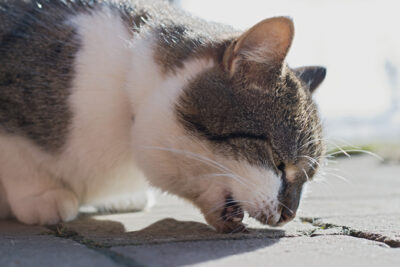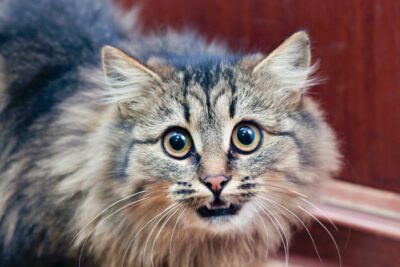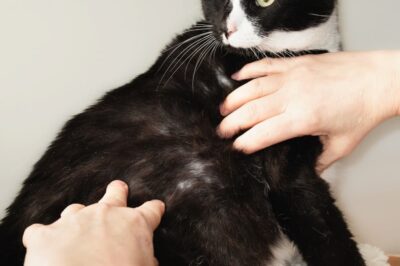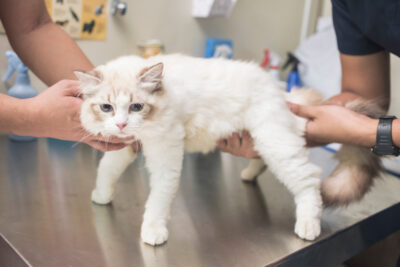Heat Stroke in Cats

Overview
When spring and summer arrive, most of us welcome the warm, sunny weather. And your kitty is no different — sunbathing is a favorite hobby among felines! However, too much time in high heat isn’t good for humans or pets. While dogs are more commonly affected, you should know that heat stroke in cats can happen, too.
Cats are typically good at finding cool spots. But in some situations, even they can’t escape the heat. Though heat stroke in cats is rare, it can be a life-threatening emergency. So, how do you know if it is happening, and what should you do?
Here’s everything you need to know about feline heat stroke. Knowing how to recognize the signs and steps you can take to help could save your cat’s life.
What Is Heat Stroke in Cats?
Normal body temperature in cats is anywhere from 99-102.5 degrees Fahrenheit (37-39 degrees Celsius). Heat stroke (also known as hyperthermia) happens when a cat’s body temperature rises above 105.8 F (41 C).
This high temperature can damage vital organs like the heart, kidneys, and digestive system. Excessive heat can also overwhelm neurons in the brain, causing brain damage. If not treated right away, heat stroke in a cat can quickly become fatal.
Both indoor and outdoor cats can suffer from heat stroke. The risk of heat stroke may increase in some cats based on various factors. Cats most at risk include:
- Older cats
- Kittens
- Overweight cats
- Cats with heart or breathing problems
- Flat-faced breeds (like Persians or Himalayans)
- Cats with dark-colored coats
- Outdoor cats in hot weather without sufficient shade or water
What Causes Heat Stroke in Cats?

Cats typically develop heat stroke from being in a hot or humid environment with no way to cool off. However, cats can also suffer heat stroke from exertion, including excessive exercise or severe seizures. Though this is relatively rare.
It’s most common in early summer. One study found that 75 percent of cat heat stroke hospitalizations happen in June or July. (1) This could be because it takes about 60 days for cats’ bodies to become used to higher temperatures.
While summer months are high-risk for heat stroke in cats, cases can occur anytime if the conditions are right. Common causes of cat heat stroke include:
- Being left in a hot car
- Getting trapped in an attic, shed, or clothes dryer
- Lack of access to shade and water outdoors
- Poor ventilation in warm rooms
- Stuffy airplane cargo holds
- Excessive exercise
- Intense seizures or tremors
- Dehydration
Signs of Heat Stroke in Cats
Recognizing cat heat stroke symptoms early is crucial. The sooner you can cool them down, the better off they will be.
However, there are many symptoms of heat stroke in cats (some of which may mirror signs of other health conditions). If you notice any of these symptoms of heat stroke in cats, act fast — it’s an emergency.
- Rapid or heavy breathing
- Panting with tongue out (unusual for cats)
- Excessive drooling or foaming at the mouth
- Deep red or very pale, grayish gums (instead of normal pink gums)
- Vomiting or diarrhea (may be bloody)
- Stumbling, trouble walking
- Acting disoriented or confused
- Weakness (unable to rise or sudden collapse)
- Seizures
- Non-responsiveness
- Seizures, i.e. full body shakes during which your cat may urinate (pee) and defecate (poop) uncontrollably
Heat Stroke vs. Heat Exhaustion in Cats
Heat exhaustion is an early warning sign that your cat is getting too hot. It’s less serious than heat stroke but still needs attention.
Fortunately, the signs of heat exhaustion in cats are markedly different from signs of heat stroke. They mostly look like steps a cat would take to try and cool themselves down.
A cat with heat exhaustion may:
- Move away from direct sunlight
- Seek out shade or a fan
- Lie down on cool surfaces like tile
- Avoid movement or exercise
- Pant slightly (without other symptoms of heat stroke)
- Seek out shade or a fan
Unlike heat stroke, cats with heat exhaustion are still alert and responsive. But if a cat can’t find a way to cool down or escape the hot conditions, heat exhaustion could become heat stroke.
What to Do if Your Cat Has Heat Stroke

If you think your cat has heat stroke, treat it as an emergency. Take immediate steps to cool your cat down. (But do it safely…Cooling your cat too fast could shock their system.) Then proceed to the nearest emergency veterinary hospital for expert help and treatment.
Here’s how to cool down a cat:
- Move your cat to a cooler area – ideally out of direct sun and into shade or air conditioning
- Place your cat on a cool surface – like tile, a granite countertop, or a wet towel
- Wet your cat’s fur – using cool or room-temperature water, mist or gently wet your cat
- Place your cat in front of a fan – to help evaporate the water and lower body temperature
- Never use ice or ice-cold water – this can cause shock
- Keep cool and head to the vet – turn on the air conditioning or open car windows during the drive
- Call your vet or emergency clinic on the way – so they are prepared for your kitty
Do your best to stay calm and focused. Knowing how to cool down a cat safely on the way to the vet could save their life.
Diagnosing Heat Stroke in Cats
Heat stroke in a cat is a medical emergency, and your vet will move quickly to assess the situation. To help them determine the correct diagnosis, be prepared to provide them with these key details:
- Your cat’s symptoms – when you noticed them, if they intensified
- How you cooled your cat – what steps you took and when, as this could affect some testing
- Any health conditions – these could impact your vet’s findings and treatment plan
There’s no specific test that can tell you whether or not your cat has heat stroke. However, your vet may run a battery of tests to assess your cat’s condition and the best course of care.
These tests may include:
- Rectal temperature – over 105 F suggests heat stroke
- Blood tests – to check organ function, electrolytes, cell condition, and ability to clot
- ECG (electrocardiogram) – to check heart rhythm
- Blood pressure monitoring – low blood pressure is common
How to Treat Heat Stroke in Cats
Treatment for cat heat stroke usually requires hospitalization. This life-threatening condition impacts blood flow, which could lead to organ failure and even death. To combat this, your vet will take steps to stabilize your cat, which may include:
- IV fluids – to improve blood flow and alleviate dehydration
- Cooling techniques – until your cat’s temperature is just above normal (this helps counter the “afterdrop,” so your cat doesn’t get too cold)
- Oxygen therapy – to help with breathing
- Antibiotics – to prevent infection that can happen when the gut lining breaks down, leaking bacteria into the bloodstream
- Medications – to protect the stomach lining and prevent ulcers
- Blood or plasma transfusions – if your cat has bleeding or clotting issues
In some cases, if a cat’s temperature drops too low due to shock, vets may also need to warm the cat up.
General Cost to Treat a Cat with Heat Stroke
Typically, cats who experience heat stroke undergo a lengthy recovery.
They may be hospitalized for several days. After discharge, they’ll require veterinary follow-ups to determine any complications resulting from their heat stroke. For example, organ failure is common in cats with heat stroke, though it may not develop right away.
The cost to treat heat stroke in cats can vary based on how sick your cat is, their recovery process, and where you live.
Here’s a general range:
- Emergency exam: $100–$200
- Diagnostic tests: $300–$800
- Hospitalization and treatment: $1,000–$3,000 or more
- Follow-up care: $200–$600
Total costs can range from a few hundred to several thousand dollars. Full recovery may take days to weeks and often includes re-checks and bloodwork to monitor your cat’s condition.
How to Prevent Heat Stroke in Cats

The best way to protect your cat is to prevent overheating in the first place. Here’s how:
- Never leave your cat in a hot car, even for a few minutes
- Keep your cat indoors on hot days, especially in humid weather
- Make sure outdoor cats have shade and fresh water
- Avoid keeping cats in hot rooms, attics, or other poorly ventilated spaces
- Always check clothes dryers before turning them on
- Maintain a healthy weight for your cat
- Watch senior cats or those with health issues more closely during hot weather
As much as your kitty might love to bask in a puddle of sunshine, remember: cats and excessive heat aren’t a good combo. Being proactive is the best way to defend your cat against the dangers of heat stroke.
Related Conditions
- Kidney failure
- Blood clotting disorders (like DIC)
- Lung damage (pulmonary edema)
- Sepsis (blood infection)
- SIRS (systemic inflammatory response)
- Irregular heart rhythms (arrhythmias)
References
- Hall, Emily J et al. “Surveillance of heat-related illness in small animals presenting to veterinary practices in the UK between 2013 and 2018.” Open veterinary journal vol. 12,1 (2022): 5-16. doi:10.5455/OVJ.2022.v12.i1.2









